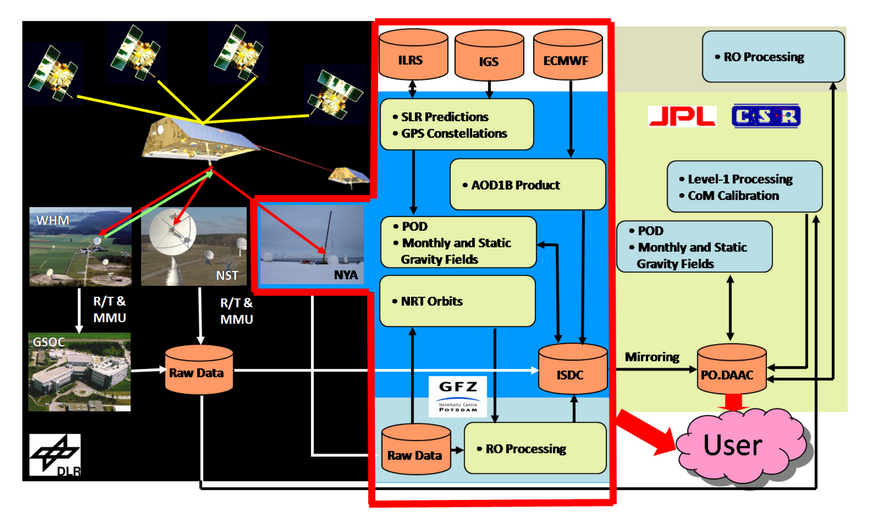All SDS Level-0 to Level-2 products are archived at JPL's Physical Oceanography Distributed Active Data Center (PODAAC) and at GFZ's Integrated System and Data Center (ISDC) where also useful documentation such as the GRACE Product Specification Document, the GRACE Level-1B Data Product User Handbook or the GRACE Level-2 Release Notes can be downloaded. Both archives are harmonized on a routine basis.
The Level-0 to Level-2 products are defined as follows:
Level-0:
The Level-0 data are the result of the data reception, collection and decommutation by the Raw Data Center (RDC) of the Mission Operation System (MOS) located in Neustrelitz/Germany. Using its Weilheim (WHM) and Neustrelitz (NST) tracking antennas, the MOS receives the science instrument and housekeeping data twice per day from each GRACE satellite which are stored in two appropriate files in the Level-0 rolling archive of the RDC. The SDS regularly retrieves these files and extracts and reformats the corresponding instrument and ancillary housekeeping data. Additionally, primarily for operational radio occultation data analysis, the raw data are also received during every pass at the GFZ polar Satellite Receiving Station (SRS) in Ny Alesund (NYA) and forwarded to GFZ in Potsdam.
Level-1:
The Level-1A data products are the result of a non-destructive processing applied to the Level-0 data. The sensor calibration factors are applied in order to convert the binary encoded measurements to engineering units. Where necessary, time tag integer second ambiguity is resolved and data are time tagged to the respective satellite receiver clock time. Editing and quality control flags are added, and the data is reformatted for further processing. The Level-1A data are reversible to Level-0, except for the bad data packets. This level also includes the ancillary data products needed for processing to the next data level.
The Level-1B data products are the result of a possibly destructive, or irreversible, processing applied to both the Level-1A and Level-0 data. The data are correctly time-tagged, and the data sample rate is reduced from the higher rates of the previous levels.
Collectively, the processing from Level-0 to Level-1B is called the Level-1 Processing. This level also includes the ancillary data products generated during this processing and the additional data needed for further processing (such as the Level-1B Atmosphere and Ocean De-aliasing Product (AOD1B).
Level-1 instrument data processing software is developed and operated by JPL.
Level-2:
Level-2 data include the short term (monthly and weekly) and static gravity field derived from calibrated and validated GRACE Level-1B data products. This level also includes ancillary data sets (e.g. mean atmospheric and oceanic mass variations) which are necessary to interpret time variability in gravity field solutions. The Level-2 processing software has been developed independently by all three processing centers. Routine processing is done at UTCSR and GFZ, while JPL is generating Level-2 products for verification purposes.
For alternative GRACE products (outside the SDS) please go to the “Links” page.


